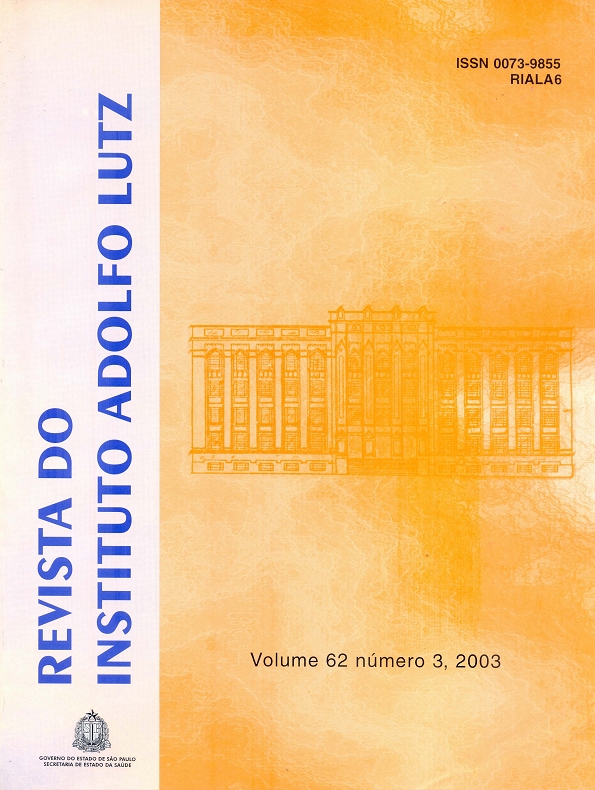Abstract
The increasing incidence of tuberculosis and other mycobacterial diseases has made it essential for laboratories to quickly detect and identify mycobacteria. A total of 791 clinical specimens were collected from patients who were HIV positive, between March and December 2000. The MB/BacTTM system has detected 30.0% of mycobacterial isolates, while 18.8% were detected by Löwenstein-Jensen medium. The automated MB/BacTTM system was more sensitive and rapid than the traditional method for mycobacterial recovery. The MB/BacTTM system plus a DNA AccuProbe identification method could be a useful tool for the TB Control Program in rapid diagnosing TB cases among HIV positive patients.
References
1. Alcaide, F. et al. Evaluation of the BACTEC MGIT 960 and the MB/BacT systems for recovery of mycobacteria from clinical specimens an for species identification by DNA Accu Probe. J. Clin. Microbiol., 38 (1): 398-401, 2000.
2. Badak, F. Z. et al. Use of nucleic acid probes for identification of Mycobacterium tuberculosis directly from MB/BacT bottles. J. Clin. Microbiol., 37 (5): 1602-1605, 1999.
3. BRASIL, Ministério da Saúde. Fundação Nacional de Saúde. Centro de Referência Professor Hélio Fraga. Manual de Bacteriologia da Tuberculose, 2ª edição, Rio de Janeiro, 1994.
4. Brunello, F.; Favari, F.; Fontana, R. Comparison of the MB/BacT and BACTEC 460 TB systems for recovery of mycobateria from various clinical specimens. J. Clin. Microbiol., 37 (4): 1206-1209, 1999.
5. Conville, P. S. & Witebsky, F. G. Inter-bottle transfer of mycobacteria by the BACTEC 460. Diagn.Microbiol. Infect. Dis., 12: 401-405, 1989.
6. Kent, P. T. & Kubica, G. P. Public Health Mycobacteriology: a guide for the level III laboratory. Atlanta, US Department of Health and Human Services, 1985.
7. Manterola, J.M. et al. Comparison of a non radiometric system with BACTEC 12B and Culture on Egg-Based Media for Recovery of Mycobacteria from clinical specimens. Eur. J. Clin. Microbiol. Infect. Dis., 17:773-77, 1998.
8. Piersimoni et. al. Comparison of MBBacT Alert 3D System with radiometric BACTEC system and Löwenstein-Jensen Aily, D.C.G. et al. - Isolamento de micobactérias em espécimes clínicos, utilizando o sistema automatizado MB/BacTTM . Rev. Inst. Adolfo Lutz, 62(3): 233 - 237, 2003. medium for recovery and identification of mycobacteria from clinical specimens: A Multicenter study. J. Clin. Microbiol., 39:651-57, 2001.
9. Roberts G.D.; Bottger E.C.; Stockman L. Methods for the rapid identification of mycobacterial species. Clinics Lab. Med., 16(3):603-13, 1996.
10. Roggenkamp, A. et al. Comparison of MB/BacT and th BACTEC 460 TB systems for recovery of mycobacteria in a routine diagnostic laboratory. J. Clin. Microbiol., 37 (11): 3711-3712, 1999.
11. Rohner, P. et al. Evaluation of de MB/BacT system in comparison to the BACTEC 460 system and solid media for isolation of mycobacteria from clinical specimens. J. Clin. Microbiol., 35(12):3127-3131, 1997.
12. Rosemberg, J. Tuberculose Panorama Global, óbices para o seu controle. Secretaria da Saúde do Estado do Ceará – 1999.
13. São Paulo, Centro de Vigilância Epidemiológica “Prof. Alexandre Vranjac”. (Informe Técnico – Campanha Estadual de Busca de Casos de Tuberculose). Alerta TB/1998.
14. Wolinsky, E. Conventional diagnostic methods for tuberculosis. Clin. Infect. Dis., 19: 396-401, 1994.
15. World Health Organization. (Laboratory Services in Tuberculosis Control.) Part III: Culture. Geneva 1998.

This work is licensed under a Creative Commons Attribution 4.0 International License.
Copyright (c) 2003 Revista do Instituto Adolfo Lutz
